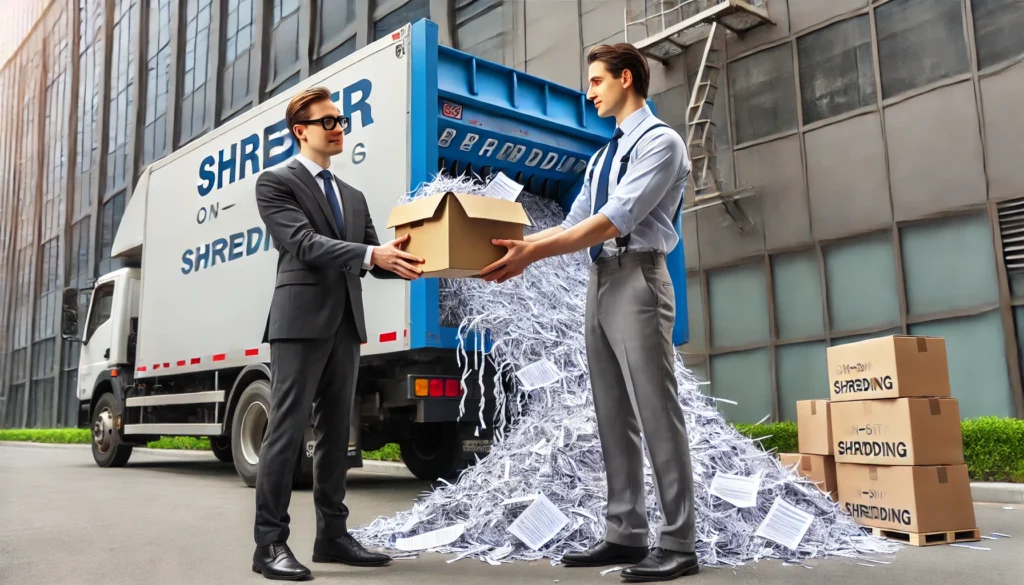Safeguarding sensitive information is more crucial than ever.
On-site shredding offers a convenient and secure solution for businesses looking to protect their confidential documents.
This article explores the benefits of on-site shredding, from ensuring compliance with legal regulations to best practices for choosing a reliable service provider.
It also covers how to prepare for an on-site shredding session, ensuring a smooth and efficient process.
Read on to discover how on-site shredding can bolster your organisation’s data security.
What is On-Site Shredding?

On-site shredding is a secure document destruction service that enables businesses to dispose of sensitive materials directly at their premises. This method provides convenience while ensuring compliance with data protection regulations.
By utilising industrial shredders, organisations can guarantee that confidential information is irretrievably destroyed, thereby minimising risks associated with identity theft and data breaches. With an increasing focus on regulatory compliance, including adherence to UK GDPR standards, many organisations are opting for on-site shredding services to protect customer confidentiality and enhance operational efficiency.
Along with enhancing security, on-site shredding offers immediate peace of mind by eliminating the risk associated with the transportation of documents off-site, where they may be vulnerable to interception. Typically, these shredding services involve a professional team arriving at the business location with specialised equipment, prepared to shred materials in real-time, allowing employees to observe the destruction process.
This level of transparency fosters trust and underscores the organisation’s commitment to safeguarding sensitive information. Furthermore, on-site shredding can be customised to meet specific compliance requirements, ensuring that companies not only protect their own information but also adhere to industry standards, thereby reducing potential legal repercussions.
Benefits of On-Site Shredding
On-site shredding provides a range of benefits that significantly enhance both security and operational efficiency for organisations. This service enables businesses to manage their shredding policies effectively while ensuring a secure method for disposing of sensitive documents.
By utilising shredding equipment on-site, organisations can guarantee the immediate destruction of confidential materials, thereby substantially reducing the risk of identity theft and data breaches. Furthermore, on-site shredding adheres to compliance requirements, thereby strengthening overall risk management strategies.
Convenience and Security
The convenience of on-site shredding is a significant factor that distinguishes it, enabling businesses to maintain operational efficiency while ensuring security. With mobile shredding services, companies can schedule a regular shredding frequency tailored to their specific requirements, guaranteeing the secure disposal of documents at their premises. This not only saves time but also reinforces the critical importance of maintaining confidentiality and data security throughout the shredding process.
Mobile shredding services further enhance this convenience by bringing the shredding unit directly to the location, thereby eliminating the challenges associated with transporting sensitive materials. Organisations can observe the shredding process firsthand, providing assurance regarding the integrity of their data disposal practices.
Incorporating on-site shredding into regular operations allows businesses to manage confidential documents more efficiently and mitigate the risk of potential data breaches. The customisable shredding frequency facilitates timely disposal, reduces clutter, and aligns seamlessly with compliance regulations.
Ensuring Compliance with On-Site Shredding

Ensuring compliance with legal requirements is a fundamental aspect of on-site shredding, as it helps businesses in adhering to various regulations related to document destruction and data protection. By collaborating with reputable shredding contractors, organisations can guarantee that their shredding processes align with regulatory compliance standards, including privacy laws and waste disposal regulations.
Moreover, compliance audits can be facilitated by implementing established shredding policies, thereby reinforcing the organisation’s commitment to data security and confidentiality.
Legal Requirements and Regulations
Understanding the legal requirements and regulations surrounding document destruction is essential for any organisation utilising on-site shredding services. Various laws, including HIPAA compliance for healthcare providers, mandate the secure disposal of sensitive information to protect data integrity and ensure privacy. Adhering to disposal regulations not only safeguards against potential fines but also enhances customer trust and demonstrates a commitment to data protection.
Organisations must remain informed about the specific mandates governing their industries, including the Privacy Rule and Security Rule outlined in HIPAA, which necessitate meticulous handling of personal health information. Additionally, other data protection laws, such as the GDPR for European customers and specific regional regulations, further emphasise the importance of maintaining privacy.
By complying with these legal frameworks, businesses can effectively mitigate risks associated with data breaches, thereby fortifying customer relationships and securing their reputations in a competitive marketplace. A proactive approach to compliance not only signifies adherence to legal obligations but also embodies a broader commitment to ethical stewardship concerning sensitive information.
Best Practices for Compliance
Adopting best practices for compliance in on-site shredding is essential for organisations aiming to maintain security and mitigate risks. Establishing clear shredding policies that define the frequency and methods of document destruction can significantly enhance compliance audits and ensure alignment with industry standards. Additionally, providing employee training on data handling and secure disposal practices reinforces the organisation’s commitment to confidentiality and data security.
To further strengthen these practices, it is imperative for organisations to ensure that their shredding facilities adhere to specific security requirements, including access control and surveillance systems.
Regular compliance audits play a critical role in assessing and validating shredding operations against established regulations. These audits not only assist in identifying potential gaps but also foster a culture of accountability and diligence within teams.
By integrating these components—robust policies, comprehensive training programmes, and secure environments—organisations effectively enhance their safeguarding measures and significantly reduce vulnerabilities associated with document disposal.
Choosing a Reliable On-Site Shredding Service
Selecting a reliable on-site shredding service is vital for organisations aiming to improve their document destruction processes while ensuring adherence to data protection regulations.
Key factors such as vendor compliance, service agreements, and the overall quality of service significantly influence the selection of an appropriate shredding service provider. A reputable shredding contractor not only meets operational standards but also reinforces the integrity of the organisation’s confidential data management practices.
Factors to Consider
When selecting an on-site shredding service, several critical factors must be considered, as they directly impact both service reliability and the cost of shredding. Organisations should evaluate the shredding technology utilised and the maintenance practices of the equipment to ensure efficiency and compliance with waste disposal regulations.
Additionally, assessing how effectively a shredding service promotes client trust through transparency and certification can significantly influence the decision-making process.
For example, the adoption of advanced shredding systems can greatly enhance the effectiveness of data destruction, thereby providing assurance that sensitive information has been rendered irretrievable. Organisations should also inquire about the frequency of equipment maintenance to minimise any potential disruptions in service.
Understanding the pricing structure—whether it is based on a per-shred basis or a flat rate—is essential for informed budgeting decisions, highlighting the importance of comparing multiple providers. Furthermore, obtaining references or reviewing customer testimonials can provide valuable insights into the experiences of other clients, emphasising the necessity of selecting a reputable shredding service that aligns with the organisation’s values and data security requirements.
Questions to Ask Before Hiring
Before engaging an on-site shredding contractor, it is essential to pose critical questions to ensure that the provider adheres to security and compliance standards. Inquire about the security measures they have implemented, such as employee training and shredding certifications, to protect confidentiality. Gaining an understanding of their insurance coverage and policies can help mitigate business liability associated with data breaches and operational failures.
Prospective clients should further investigate the contractor’s chain-of-custody processes, which ensure that sensitive information is protected from the point of collection to its eventual destruction. It is also imperative to inquire about their compliance with industry regulations, such as the Data Protection Act or GDPR, depending on the type of data being shredded.
Request specific details regarding the frequency of equipment maintenance and the protocols followed to verify the effectiveness of their shredding machinery. Additionally, it is advisable to confirm whether the contractor provides a certificate of destruction upon completion, which serves as tangible proof of compliance and assurance of security.
Preparing for On-Site Shredding

Preparing for on-site shredding necessitates meticulous planning and organisation to facilitate an efficient shredding process that adheres to operational protocols. Organisations should begin by systematically organising and categorising documents according to their sensitivity and the established shredding schedule. This approach will enhance the overall efficiency of the shredding process.
Furthermore, implementing employee training on appropriate document disposal methods can promote a culture of compliance and confidentiality within the organisation.
Organizing and Sorting Documents
Organising and sorting documents prior to on-site shredding is essential for maintaining confidentiality and ensuring compliance with data management policies. Organisations should categorise documents according to their shredding frequency and retention policies, facilitating efficient processing and secure destruction of sensitive materials. This proactive approach not only streamlines the shredding process but also reinforces the organisation’s commitment to data protection.
Before shredding, it is advisable to establish a clear framework for document classification that aligns with regulatory mandates. Implementing regular reviews of document storage can assist in identifying items that are ready for destruction and those that require longer retention.
By engaging employees in this systematic sorting process, organisations can enhance accountability and ensure that sensitive client information is managed appropriately. Furthermore, promoting a culture of confidentiality through training will solidify the importance of adhering to effective data management practices, ultimately safeguarding against potential data breaches.
Properly Packaging Documents for Shredding
Properly packaging documents for shredding is critical for secure disposal and efficient processing. Organisations should utilise designated containers or bins to store sensitive materials until the shredding service arrives, ensuring that employee training emphasises the importance of adhering to operational protocols for document handling. This meticulous approach to waste management not only safeguards confidentiality but also ensures compliance with disposal regulations.
To enhance the security of this process, it is imperative to train employees on how to identify documents that necessitate shredding, including financial records, client information, and internal reports. Establishing clear guidelines regarding the storage of these items prior to disposal is also essential. Employees should be informed about the specific types of containers that are appropriate for shredding materials to prevent any accidental exposure.
Regular audits of the shredding process can further reinforce these protocols, providing assurance that sensitive information is managed with the utmost care. This, in turn, fosters a culture of security within the organisation.
Frequently Asked Questions
What is the purpose of ensuring compliance with on-site shredding services?
Ensuring compliance with on-site shredding services is important for maintaining the security and confidentiality of sensitive information. It also helps organisations comply with legal and regulatory requirements, such as the General Data Protection Regulation (GDPR) and the Health Insurance Portability and Accountability Act (HIPAA).
How can I ensure compliance with on-site shredding services?
To ensure compliance with on-site shredding services, it is important to partner with a reputable and certified shredding company. They will follow strict security protocols and provide a certificate of destruction, ensuring that all documents are properly destroyed and disposed of.
Why is it important to use on-site shredding services instead of off-site shredding?
On-site shredding services offer a higher level of security and compliance compared to off-site shredding. With on-site shredding, documents are destroyed on the premises, eliminating the risk of sensitive information being lost or stolen during transportation.
What types of documents should be shredded on-site?
All types of documents that contain sensitive information, such as personal and financial information, should be shredded on-site. This includes documents such as contracts, financial records, legal documents, and employee records.
Are there any regulations or laws that require compliance with on-site shredding services?
Yes, there are several regulations and laws that require compliance with on-site shredding services. These include the GDPR, HIPAA, the Fair and Accurate Credit Transactions Act (FACTA), and the Sarbanes-Oxley Act (SOX), among others.
What are the consequences of not ensuring compliance with on-site shredding services?
The consequences of not ensuring compliance with on-site shredding services can be severe. It can result in data breaches, financial penalties, loss of reputation and trust, and potential legal action. Non-compliance can also damage an organisation’s credibility and lead to loss of business.

